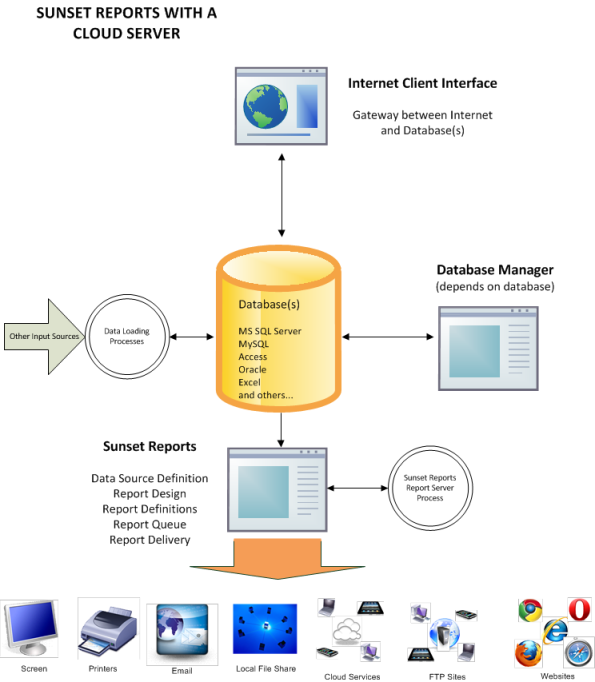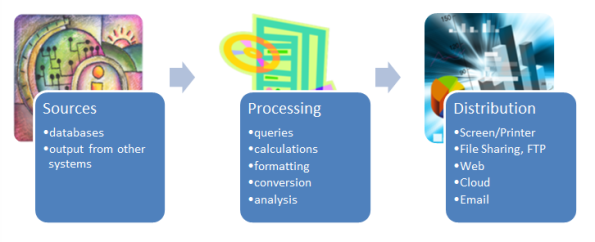Archive
Quick Introduction
Sunset Reports is based on award winning components and proven technology, and provides users an alternative to such software as Crystal Reports, SSRS, and others. The report designer handles all types of content. And you can even import report designs from other software as well. The report queue allows for scheduling of reports, file and document distribution including recurring schedules and provides easy to use list and calendar views. Besides using Sunset Reports as a reporting tool, it is perfect for information management, data analysis, business analytics, visualizations, web site design, making labels, data conversion, document management, document distribution, and lots more.
All In One Software
As we continue to see how people use Sunset Reports, we are amazed to find out that the product can do so much. In surveying our current user base, we have found the functionality of the software going beyond what we originally intended. Here is a small list of how the software has been used (The first few were obvious, but included here to make the list as complete as possible.)
- Reporting Tool
- Data Analysis
- Business Analytics
- Management Dashboards
- Charting
- Visualizations
- Business Graphics
- Web Site Design
- Web Page Designer
- Label Maker
- Word Processor
- Dunning Letters
- Data Conversion Tool
- Document Management
- Document Distribution
- FTP Client
- File Backup Manager
- Report Server
- Report Subscriptions
- Meeting Presentations
- Report Scheduler
- Model What-if Scenarios
- Email Blasts
If you are using the product for something not on this list, drop us a line, we would love to hear from you.
Report Server
Sunset Reports can work as a “Report Server” similar to SQL Server Reporting Services (SSRS) and Crystal Reports. The difference is Sunset Reports is much easier to implement and does not provide a web based interface. No actual server software exists. Instead a Windows Service is run on any Windows based computer including XP, Vista, 7, Server 2003, and Server 2008. The service or “Report Processor Service” as we refer to it, runs in the background whether a user is logged on or not. It runs off a report queue which has a list of reports to run, their scheduled time, format, destination, etc. Reports can be added via the Windows based user interface, or from an email request. The Report Processor Service also monitors an incoming email inbox for requests. Reports can be saved in a variety of formats and even FTP’d to a website.
Cloud Server
In some upcoming posts, the details of how to implement a Cloud Server with Sunset Reports will be discussed. The following diagram shows the basis of this discussion. This architecture has been used for projects where a database client was running on an iPad, and this client would synchronize with it’s server counterpart and keep a set of database tables up to date both on the iPad and the Server. Then Sunset Reports was used to create the reports needed and pushed those reports to the client on a schedule and as requested.
Business Asset
One of the most important assets in business is DATA and when the data is turned into INFORMATION, it becomes the primary asset of a business. Transforming data from a variety of sources, making it accessible, and presenting it in a form that is useful is the main purpose of Sunset Reports. Timely information and business intelligence in the right format gives managers the ability to
- Make quicker decisions
- Make smarter dicisions
- Adapt to changes
- Affect the bottom line
With Sunset Reports, you do not have to manually run reports, they can be delivered on demand or scheduled to occur on a recurring basis. They can be delivered to a manager’s workstation or portable device like a smartphone or tablet. They can show up on a website, email, or message.
Preferences
Prior to designing reports, you should establish your preferences. Click on the Preferences block on the Navigator, or use the pull down menu Edit – Preferences.
The preferences form contains tabs which group the preferences into related areas. The form itself should have enough information about each of the preferences so you know what to enter.
If you would like to have the time of sunset each day be displayed on your splash screen and available for schedule of reports, you need to add the latitude and longitude of your location on the Preferences form. There are a number of ways to do this from using a GPS at your location, to going to various websites that provide that information when you enter a city or zip code. Here is a simple method. Go to Google Maps. Zoom into your location. Right mouse click on your location and select “What’s here?” On the top of the web page in the search box, is the latitude and longitude. They are even in the right format. Enter the first number as the latitude on the preferences form and the second number as the longitude.
The Email tab contains the preferences to establish the connection to the SMTP server that will be used to send emails as well as the default values for the Email messages. If you are going to send password protected PDF attachments, enter the password here.
The FTP preferences include the required items to send a report file to an FTP site. By default the files will be sent to the root folder of the FTP site, but you can have subfolders and you can specify the subfolder as the destination folder when defining the Report Queue entry. Only reports processed from the queue can be sent to an FTP site.
Sunset Reports has the ability to create a semi-dynamic web site that does not require a web server. This is ideal for creating a web site and not having the complications of a web server. Since Sunset Reports can automatically create web pages and update the web site, it is referred to as a semi-dynamic web site. The Web preference to “Create Home Page” if set to yes, will create an index.htm file in the repository so the repository can be a local static web site for reports and the home page will contain links to the files. Files indexed include PDF, HTML, HTM, and MHT. If an IndexMaster.htm file exists, it will be used as part of the Home Page. This allows you to create a custom home page with a logo. If you do not have this file, a default home page will be created. The repository may contain subfolders and these are treated as groups and will appear as a link on the parent index.htm and will open a new index.htm file created in the subfolder. This allows you to group reports and organize the static web site more. You might also use this feature to provide security on the website, using Windows security to give access to users by subfolder.
The Data preferences are optional but very useful. By establishing a common data connection, creating data sources becomes real easy. The tab contains the preferences “Primary/Preferred Data Connection” (PDC) and “Secondary Data Connection” (SDC). These are data connection strings that are very specific to the database you are connecting to. Note that your reports are not just limited to these two data connections. By changing this preference, all report designs with the data source type PDC or SDC will be updated to the new data source. Creating the PDC and SDC is made easy by using the Report Designer wizard or the Query Builder.
Information Management
If you refer to the definition of “Information Management (IM)” from Wikipedia, you will see that IM “is the collection and management of information from one or more sources and the distribution of that information to one or more audiences. …. the organization of and control over the structure, processing, and delivery of information”
Does this definition describe Sunset Reports? Actually this definition is exactly what Sunset Reports does. You can define many sources of information from databases, Excel documents, or any other type of file created by another system. With the query builder, report designer, calculations, scripting, etc., information can be processed. The delivery of information can take many forms in terms of file formats. Delivery can be scheduled and there are several destination types including websites, shared folders, cloud services, email, and more.
Use on Mobile Devices
Sunset Reports can work as a great tool for viewing reports on mobile devices like the iPhone, iPad, or other smartphone via Email, FTP, or Web pages. The Push/Pull capabilities via Email and the report server function in Sunset Reports provides everything you need for viewing reports. Report design is best handled on the Windows based hardware where the databases generally reside.
The PDF’s generated by Sunset Reports can be sent to your iPhone and iPad and they look great and are easy to view using iBooks. 
A good scenerio used by many users is to receive reports from Sunset Reports each morning via email on their iPad. The email comes to you when you are at home when you are connected via WiFi. Then when you leave for the day, your iPad has the reports you need without an internet connection. This process works great. You never have to wait for your reports to run or download. They are there when you need them and the PDF quality is wonderful. You can even forward or share the reports as necessary.



